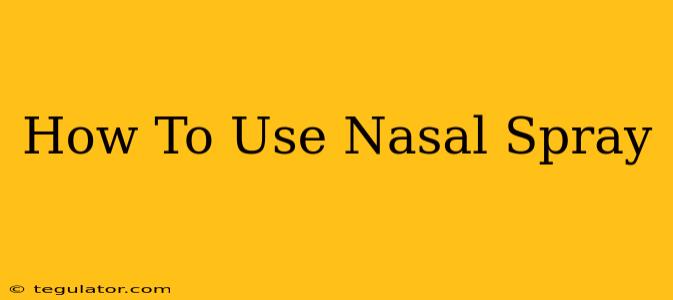Nasal sprays offer quick relief from congestion, allergies, and other nasal issues. However, improper use can reduce effectiveness or even irritate your nasal passages. This comprehensive guide will walk you through the correct way to use nasal spray, maximizing its benefits and minimizing potential side effects.
Understanding Your Nasal Spray
Before diving into the application process, it's crucial to understand the type of nasal spray you're using. Different sprays have different purposes and may require slightly varied techniques. Common types include:
- Decongestants: These provide temporary relief from stuffiness by shrinking swollen blood vessels in the nasal passages. Important Note: Overuse of decongestant nasal sprays can lead to rebound congestion, making your symptoms worse in the long run. Always follow the recommended dosage and duration of use.
- Steroid nasal sprays: These are often used for long-term allergy management. They reduce inflammation in the nasal passages, providing longer-lasting relief than decongestants. They are generally safe for prolonged use when prescribed by a doctor.
- Saline sprays: These are simple salt-water sprays that help to rinse and moisten the nasal passages. They are generally safe for frequent use and are often recommended to help clear out allergens or irritants.
Step-by-Step Guide to Using Nasal Spray
Regardless of the type of nasal spray, the following steps will ensure proper application:
1. Preparation is Key:
- Read the Instructions: Always carefully read the instructions provided with your specific nasal spray. Each product might have slight variations in application techniques.
- Wash Your Hands: Thoroughly wash your hands with soap and water to prevent the introduction of germs into your nasal passages.
- Prime the Spray (if necessary): Some nasal sprays require priming before the first use, and potentially after periods of non-use. This usually involves pressing the pump several times until a fine mist is produced. Check your product's instructions.
2. Proper Posture:
- Stand or Sit Upright: Avoid using the spray while lying down. This can cause the medication to drip down the back of your throat instead of targeting your nasal passages.
- Gentle Head Tilt: Gently tilt your head slightly forward. This helps the spray reach the affected areas more effectively.
3. Application Technique:
- Insert Nozzle: Gently insert the nozzle into one nostril. Avoid forcing it in too far.
- Close Opposite Nostril: Close the opposite nostril with your finger.
- Spray and Breathe: While spraying, breathe in gently through your nose. This helps to distribute the medication evenly.
- Repeat: Repeat steps 2 and 3 for the other nostril.
4. Post-Application:
- Wait a few minutes before blowing your nose: This allows the medication to settle and work its magic. Avoid blowing your nose too hard, which can irritate sensitive nasal passages.
- Clean the Nozzle: After each use, wipe the nozzle clean with a tissue to prevent contamination.
5. Storage:
- Store Properly: Store your nasal spray according to the instructions on the packaging. This usually involves keeping it at room temperature, away from direct sunlight and excessive heat or cold.
Common Mistakes to Avoid
- Overuse: Avoid overusing decongestant nasal sprays, as this can lead to rebound congestion. Always follow the dosage instructions.
- Incorrect Posture: Using the spray while lying down can lead to less effective distribution of the medication.
- Forcing the Nozzle: Forcing the nozzle into your nostril can cause discomfort and potential injury.
- Ignoring Instructions: Always read and follow the instructions provided with your specific nasal spray.
When to Consult a Doctor
If your nasal congestion or other symptoms persist despite using nasal spray, or if you experience any adverse reactions, consult your doctor immediately. They can help determine the underlying cause of your symptoms and recommend the appropriate treatment.
By following these simple steps and avoiding common mistakes, you can effectively use your nasal spray and experience the relief it offers. Remember to always consult your doctor or pharmacist if you have any questions or concerns about using nasal spray.

